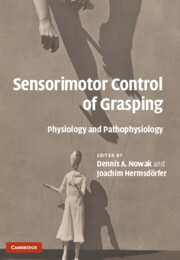Book contents
- Frontmatter
- Contents
- List of contributors
- Preface
- Part I Methodology
- Part II The physiology of grasping
- 10 The study of hand movements during grasping. A historical perspective
- 11 Sensory control of object manipulation
- 12 Predictive mechanisms and object representations used in object manipulation
- 13 The neurohaptic control of the hand
- 14 Points for precision grip
- 15 Two hands in object-oriented action
- 16 Dynamic grasp control during gait
- 17 Development of grasping and object manipulation
- 18 The effects of aging on sensorimotor control of the hand
- Part III The pathophysiology of grasping
- Part IV Therapy of impaired grasping
- Index
- Plate section
- References
17 - Development of grasping and object manipulation
Published online by Cambridge University Press: 23 December 2009
- Frontmatter
- Contents
- List of contributors
- Preface
- Part I Methodology
- Part II The physiology of grasping
- 10 The study of hand movements during grasping. A historical perspective
- 11 Sensory control of object manipulation
- 12 Predictive mechanisms and object representations used in object manipulation
- 13 The neurohaptic control of the hand
- 14 Points for precision grip
- 15 Two hands in object-oriented action
- 16 Dynamic grasp control during gait
- 17 Development of grasping and object manipulation
- 18 The effects of aging on sensorimotor control of the hand
- Part III The pathophysiology of grasping
- Part IV Therapy of impaired grasping
- Index
- Plate section
- References
Summary
Summary
The development of skilled hand movements such as grasping and object manipulation is of fundamental importance to the ability to perform everyday life activities. The purpose of this chapter is to provide an overview on development of grasping and object manipulation. The first part describes developmental characteristics of prehension, i.e. reaching and grasping. The second part deals with the development of independent finger movements, which is an important prerequisite for both grip formation and object manipulation. In the third part, aspects of manipulation of unstable and stable objects are discussed. This includes discussion of the development of sensory control mechanisms, i.e. adaptation to friction and weight of the manipulated object. Finally, the concept of neuronal group selection, a concept that implies that development is the result of complex interaction between genes and environment, is described.
Introduction
Prehension (i.e. reaching and grasping) and manipulation of objects are motor skills that are fundamentally important for exploration and interaction with the environment. Although human infants can grasp from an early age, it takes several years before children are able to perform these skills in a mature pattern. The development of these skilled hand movements and underlying neural mechanisms is the focus of this chapter.
Prehension involves two main components, i.e. reaching and grasping. First, the hand has to be moved to the location of the object. Second, the grip must be adapted to size, shape, orientation and the intended use of the object (see also Chapters 1 and 12).
Information
- Type
- Chapter
- Information
- Sensorimotor Control of GraspingPhysiology and Pathophysiology, pp. 235 - 249Publisher: Cambridge University PressPrint publication year: 2009
References
Accessibility standard: Unknown
Why this information is here
This section outlines the accessibility features of this content - including support for screen readers, full keyboard navigation and high-contrast display options. This may not be relevant for you.Accessibility Information
- 6
- Cited by
